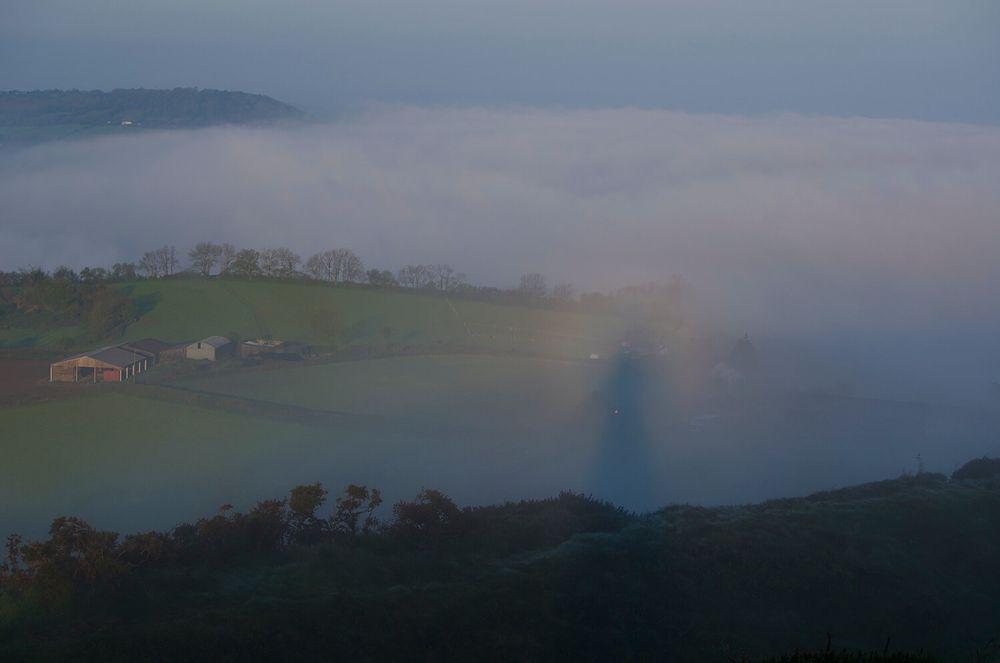
Website: www.kerrieanngardner.co.uk

Soft pastel on Pastelmat.

Soft pastel on Pastelmat.





‘E’ is for Earth’s Shadow. Visible at twilight opposite the Sun, Earth’s Shadow is seen as a dark wedge on the horizon below the Belt of Venus. Its umbra extends 870,000 miles into space. It also gives us lunar eclipses. Total lunar eclipses turn the Moon bright red!

‘E’ is for Earth’s Shadow. Visible at twilight opposite the Sun, Earth’s Shadow is seen as a dark wedge on the horizon below the Belt of Venus. Its umbra extends 870,000 miles into space. It also gives us lunar eclipses. Total lunar eclipses turn the Moon bright red!
‘C’ is for Crepuscular Rays. These are the sunbeams which shine out from gaps in clouds. Particles in the air scatter the light and make the beams visible. This phenomenon is also know as ‘God Rays’, as if a celestial being is casting them out as a symbol of hope.

‘C’ is for Crepuscular Rays. These are the sunbeams which shine out from gaps in clouds. Particles in the air scatter the light and make the beams visible. This phenomenon is also know as ‘God Rays’, as if a celestial being is casting them out as a symbol of hope.
‘C’ is for cloud iridescence. This colourful optical phenomena appears on clouds close to the Sun or Moon. It’s caused by diffraction (small water droplets or ice crystals scatter the light) and is also called irisation, after the Greek goddess of rainbows, Iris.

‘C’ is for cloud iridescence. This colourful optical phenomena appears on clouds close to the Sun or Moon. It’s caused by diffraction (small water droplets or ice crystals scatter the light) and is also called irisation, after the Greek goddess of rainbows, Iris.
Today we move on to the letter ‘C’ beginning with a Circumzenithal Arc (CZA). This phenomenon is caused by sunlight refracting through ice crystals in cirrus or cirrostratus clouds. It looks like an upside-down rainbow & is sometimes called a ‘smile in the sky’.

Today we move on to the letter ‘C’ beginning with a Circumzenithal Arc (CZA). This phenomenon is caused by sunlight refracting through ice crystals in cirrus or cirrostratus clouds. It looks like an upside-down rainbow & is sometimes called a ‘smile in the sky’.
Still on the letter ‘B’, tonight I’m focusing on the Brocken spectre; the magnified shadow of an observer cast on a cloud opposite a light source. This shadow is surrounded by a halo known as a glory. It’s named after the Brocken, a mountain in Germany where it’s often seen.

Still on the letter ‘B’, tonight I’m focusing on the Brocken spectre; the magnified shadow of an observer cast on a cloud opposite a light source. This shadow is surrounded by a halo known as a glory. It’s named after the Brocken, a mountain in Germany where it’s often seen.
Time for the letter 'B', starting with The Belt of Venus.
This atmospheric phenomenon is caused by backscattering. It's a band of pink seen close to the horizon during twilight. Look west before sunrise and east after sunset. The dark blue area below it is Earth's shadow.

Time for the letter 'B', starting with The Belt of Venus.
This atmospheric phenomenon is caused by backscattering. It's a band of pink seen close to the horizon during twilight. Look west before sunrise and east after sunset. The dark blue area below it is Earth's shadow.
www.etsy.com/uk/shop/Sara...
#selfemployedartist #ukgifthour #shopindie

www.etsy.com/uk/shop/Sara...
#selfemployedartist #ukgifthour #shopindie
Time for aurora!
In a nutshell, aurorae are produced when charged particles from the Sun interact with the Earth’s magnetic field. The different colours are caused by various gases in Earth’s atmosphere.
It’s one of my favourite atmospheric optical phenomena - magical! ✨

Time for aurora!
In a nutshell, aurorae are produced when charged particles from the Sun interact with the Earth’s magnetic field. The different colours are caused by various gases in Earth’s atmosphere.
It’s one of my favourite atmospheric optical phenomena - magical! ✨
Apologies about this photograph, as it doesn’t showcase this phenomenon particularly well, but here are some faint anti-crepuscular rays. These beams can be seen opposite the sun, converging toward the antisolar point. They are caused by cloud shadows and atmospheric haze.

Apologies about this photograph, as it doesn’t showcase this phenomenon particularly well, but here are some faint anti-crepuscular rays. These beams can be seen opposite the sun, converging toward the antisolar point. They are caused by cloud shadows and atmospheric haze.
Still on the letter ‘A’, tonight it’s Alpenglow, from the German word Alpenglühen, which means ‘Alps glow’. Alpenglow refers to the reddish colour seen on mountain peaks at dawn and dusk.
Have you seen Alpenglow? Please share your pictures if you have, I’d love to see. ⛰️

Still on the letter ‘A’, tonight it’s Alpenglow, from the German word Alpenglühen, which means ‘Alps glow’. Alpenglow refers to the reddish colour seen on mountain peaks at dawn and dusk.
Have you seen Alpenglow? Please share your pictures if you have, I’d love to see. ⛰️
Another ‘A’ today - Alexander’s Band.
If you look closely at a double rainbow, you’ll see a darker area between the primary & secondary bow. This is Alexander’s Band. It appears darker because light in this area is being scattered at angles which don’t reach the viewer’s eyes.

Another ‘A’ today - Alexander’s Band.
If you look closely at a double rainbow, you’ll see a darker area between the primary & secondary bow. This is Alexander’s Band. It appears darker because light in this area is being scattered at angles which don’t reach the viewer’s eyes.
Still on the letter 'A', today I'm sharing airglow.
Airglow is caused by atoms & molecules in the upper atmosphere which, having been excited by sunlight during the day, emit light at night as they shed excess energy. This is called chemiluminescence.
(Cont'd in alt text.)

Still on the letter 'A', today I'm sharing airglow.
Airglow is caused by atoms & molecules in the upper atmosphere which, having been excited by sunlight during the day, emit light at night as they shed excess energy. This is called chemiluminescence.
(Cont'd in alt text.)
'A' is for afterglow.
As far as I understand it, afterglow refers to an intense red glow along the horizon after the sun has set. It's caused by dust in the stratosphere.
This, near Lyme Regis, UK, is one of the best examples I've seen.
Have you seen it, too?

'A' is for afterglow.
As far as I understand it, afterglow refers to an intense red glow along the horizon after the sun has set. It's caused by dust in the stratosphere.
This, near Lyme Regis, UK, is one of the best examples I've seen.
Have you seen it, too?
Perhaps I should explain. I often photograph the sky yet most of my pictures are squirrelled away. But what better place to share them than on a platform called Bluesky?
So, all this month, I'll endeavour to share my pics of atmospheric optics. 😎
Perhaps I should explain. I often photograph the sky yet most of my pictures are squirrelled away. But what better place to share them than on a platform called Bluesky?
So, all this month, I'll endeavour to share my pics of atmospheric optics. 😎
@kerriedoodles.bsky.social—all the thoughts & emotions (Linnets blog).
@kerriedoodles.bsky.social—all the thoughts & emotions (Linnets blog).


